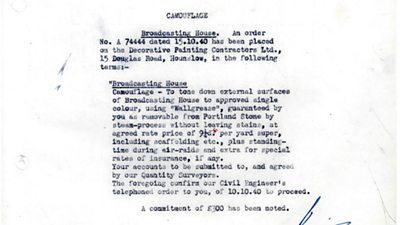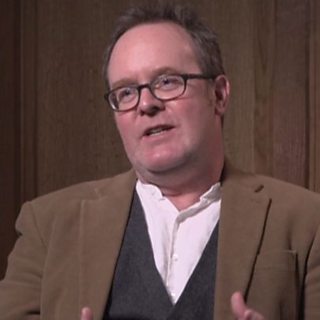The ����ý’s iconic headquarters, Broadcasting House in London, suffered two direct hits in the Blitz, causing widespread damage, several deaths, and many injuries. It was a stark reminder that the ����ý was high on the list of enemy targets. It also showed that broadcasters, like the rest of the British population, were experiencing first-hand the horrors of war on the home front. Here, newly-released eye-witness accounts from the ����ý’s own archives provide the most complete account so far of these 1940 bombings.
The most famous story of the devastating bomb which landed on Broadcasting House on the night of Tuesday 15 October 1940, was that it was heard live on air by millions of listeners who had tuned-in for the 21.00 news, read that evening by Bruce Belfrage sitting in a basement studio of the building.
The bulletin itself was not recorded, but ten years later Belfrage recreated the moment for a special anniversary programme:
Soon after the war, Belfrage also gave ����ý listeners his own account of what happened. It provided an explanation for his own brief pause and for the mystery voice that many listeners heard faintly in the background saying "it’s alright!":
But Belfrage was not the only witness to the October bombing. Indeed, since he was sitting in the news studio when the explosion occurred, he was hardly in the best position to describe the full sequence of terrible events that night.
Fortunately, there were others there who survived to tell their own tale of what happened. And the accounts they gave, preserved in the ����ý’s archives, are like pieces of a complex jigsaw, helping us to piece-together a much fuller picture of what happened.
The bomb, a large one, weighing over 225kg, exploded at exactly one minute and fifty seconds past nine. But as Belfrage suggested, it had actually landed earlier in the evening.
At exactly 20.05, the bomb had burst through the window of the ����ý’s switchboard on the 7th floor, crashed through the inner ‘tower’ of the building, and come to rest in the fifth-floor Music Library. There were other bombs falling nearby at the time, and the noise and damage it caused on its journey was so great that no-one realised at first that it was actually a ‘delayed action’ device which hadn’t yet exploded.
It was actually only found at 20.34, and even then, its true nature was only established after another twelve minutes. By now, the ����ý’s own defence staff knew it could go off at any moment and the first serious attempts were made to evacuate surrounding areas of the building.
Harold Bishop was one of the senior engineers on duty at the time, and gives this account of what happened next:
Bishop’s account isn’t entirely reliable. He remembers nine deaths. In fact, six people were killed that night, a seventh died of his injuries later. He also implies, a little misleadingly, that it might have been the fumbled attempt to move the bomb which triggered its detonation: actually, there was no evidence this was the case.
Even so, his account is very telling. He’s clearly proud of the fact that programmes stayed on air throughout – a testament to the building design, but also perhaps to the determination of ����ý staff to continue their ‘war work’.
It was, alas, this very determination to keep working which probably led to several needless fatalities. Mary Lewis’s account offers a few more clues. She had left her post at the Duplicating Section for the night and, like Bishop, was taking shelter in the Basement.
Like Bishop, too, she was incredibly relieved that the building itself had withstood the worst. Unlike him, she had noticed some ominous sounds coming from the third-floor:
Rescue teams were indeed drilling through the rubble. Two floors below the Music Library, Studio 3A had been bustling with staff from the ����ý’s Monitoring unit. They’d been busy processing the latest transcripts of foreign radio output sent by tele-printer from their colleagues at Wood Norton, where the actual eavesdropping was done.
At 20.48, the Director-General himself had ordered the immediate evacuation of all upper floors, but several members of the Monitoring team were reluctant to move.
There are no oral history interviews with anyone inside Studio 3A itself that night. But among the ����ý’s archives are several written accounts of the explosion, including this one, from a G.C. Browne, who was working in the studio’s outer office:
Only when the dust had settled, could anyone make full sense of what exactly happened. It turned out that three people, including a fireman, Mr Robilliard, had just started trying to move the bomb when its timer expired: Robilliard himself was killed instantly.
Several members of the Monitoring unit two floors below had not yet left Studio 3A, and four members of the unit therefore also died in the explosion, along with another member of the ����ý’s own fire squad.
A member of the ����ý’s defence staff, Mr Gaetjens, was severely injured and died two days later. Several others were hospitalised.
The ����ý set up a committee of enquiry the day after the bombing, to see if more lives could have been saved.
It tried hard not to point the finger of blame, and praised both the bravery of the firefighters and the initiative of a young Overseas Presentation Assistant, Mr Carse, who, as G.C. Browne’s account shows, had first warned the Monitoring staff of the grave danger they were in.
However, there had been unnecessary confusion about the nature of the bomb, early messages had implied it was merely an unexploded detonator, and unnecessary confusion, too, over whether defence staff had the power to order ����ý staff out of their own building.
There is one more document in the ����ý’s archives which throws further, and rather tragic light, on the October bombing.
There had long been anxiety that with its gleaming white Portland stone, Broadcasting House was simply too visible a target for the Luftwaffe’s bombers.
In the first week of October, a group of nearby residents had even complained formally to the ����ý that they were fed-up with being targeted. In response, the ����ý decided that it would, indeed, ‘tone down’ the building with some subtle camouflage paint.
As the piece of paper below shows, the order for the work to begin was dated ’15.10.40’ – a matter of hours before the building was hit.

By 14 November, the camouflage paint had been applied. But its effect must have been minimal.
Just after 22.00 on Sunday 8 December, a huge landmine floated down into Portland Place, near the entrance to Broadcasting House, before exploding. This time, there were fewer casualties, but the damage to ����ý facilities was more severe.
One of those inside the building at the time was Alec Sutherland, from the ����ý’s Recorded Programme department:
Though the 'boffins' took away MacGregor’s recording, a typed version of his account survives in the ����ý’s written archives, and can be downloaded here in its entirety.
In it, he describes a scene 'like Dante’s Inferno'. He was clearly lucky to be alive, and this detailed first-person account provides a rare and incredibly vivid description of what it’s like to be very close to a bomb when it explodes.
In the immediate aftermath of the landmine going off, the main concern of ����ý staff, it seems, was to ensure their work could continue without a break in output. One of those on duty at the time was Elisabeth Barker, who worked for the ����ý’s European Service.
In this archive recording, she describes the first moves to evacuate Broadcasting House that night, as the fires – and the flooding – started to spread:
In another part of Broadcasting House, Alec Sutherland was also attempting to gather-up precious recordings and take them to place of safety, so that no programmes would be lost in the coming hours and days.
In all the chaos, this was obviously easier said than done, and the only solution was, it seems, a mix of subterfuge and financial recklessness:
In the end, the ����ý – and those who worked for it – had to accept that they were likely to remain under attack as long as the war itself continued. Other buildings would indeed be hit – and more than once.
In June 1944, Bush House, which the ����ý had only recently occupied, would be severely damaged by one of the Nazi’s 'flying rockets'.
In the meantime, one final secret plan was put in place at the ����ý’s headquarters: the building of a bomb-proof bunker, in which the most secure studios in the entire country would be capable of staying on air even in the face of the most devastating attack.
The ����ý’s engineer, Francis McLean was one of those responsible for its creation:
Further reading:
- Bruce Belfrage, One Man and His Time (1951)
- Juliet Gardiner, The Blitz: The British Under Attack (2010)
- Richard Overy, The Bombing War: Europe 1939-1945 (2014)

